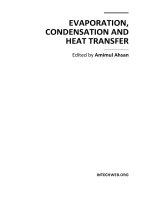Evaporation Condensation and Heat transfer Part 7 docx
Bạn đang xem bản rút gọn của tài liệu. Xem và tải ngay bản đầy đủ của tài liệu tại đây (4.22 MB, 40 trang )
⎧
⎪
⎪
⎪
⎪
⎪
⎪
⎨
⎪
⎪
⎪
⎪
⎪
⎪
⎩
∑
∑
∑
k
hhh
Cr Ar B
CODYRUNα
α
window
absorber
airstream
radiation
convection
CODYRUN
4.2.3.1 Inverse thermo-circulation evidence
4.2.3.2 Night hole closing system
4.2.3.3 Global Trombe wall functioning
4.2.3.4 Trombe-Michel wall and recycling variant comparison
Heat Transfer in the Transitional Flow Regime
JP Meyer and JA Olivier
University of Pretoria,
Department of Mechanical and Aeronautical Engineering,
South Africa
1. Introduction
Transitional flow, whereby the motion of a fluid changes from laminar to turbulent flow,
was successfully identified by Reynolds (1883) almost 130 years ago. According to ASHRAE
(2009), for a round pipe, in general, laminar flow exists when the Reynolds number is less
than 2 300. Fully turbulent flow exists when the Reynolds number is larger than 10 000 and
transitional flow exists for Reynolds numbers between 2 300 and 10 000. Despite much work
on transition and even though it is of considerable importance in determining pressure drop
and heat transfer in convective flow, the underlying physics and the implications of this
phenomenon have eluded complete understanding (Obot et al., 1990).
ASHRAE further states that predictions are unreliable in the transitional flow regime.
Cengel (2006) mentions that although transitional flow exists for Reynolds numbers between
2 300 and 10 000, it should be kept in mind that in many cases the flow becomes fully
turbulent when the Reynolds number is larger than 4 000. It is normally advised when
designing heat exchangers to remain outside the transitional flow regime due to the
uncertainty and flow instability in this region. For this reason, little design information is
available with specific reference to heat transfer and pressure drop data in the transitional
flow regime.
It has been known that there is a relationship between pressure drop and heat transfer
generally referred to as the Reynolds analogy. Therefore, the relationship between friction
factor and Nusselt number was studied by many and an overview of all the contributions on
the subject is given by Colburn (1933). Obot et al. (1990) followed up on this previous work
to investigate the role of transition in determining friction and heat transfer in smooth and
rough passages. Later on they (Obot et al., 1997) took measurements of heat transfer and
pressure drop in smooth tubes in laminar, transitional and turbulent flow over a wide range
of Prandtl numbers.
García et al. (2005) experimentally investigated helical wire coils fitted inside a round tube
in order to characterise their thermohydraulic behaviour in laminar, transitional and
turbulent flow. They did experiments over a wide range of Reynolds and Prandtl numbers
and they found that at low Reynolds numbers, wire coils behave as a smooth tube but
accelerate transition to critical Reynolds numbers down to 700. Furthermore, within the
transition region, if wire coils are fitted inside a smooth tube heat exchanger, the heat
transfer rate can be increased up to 200% while maintaining a constant pumping power.
This is in comparison with the turbulent flow regime where wire coils increase pressure
drop up to nine times and heat transfer up to four times compared with empty smooth
Evaporation, Condensation and Heat Transfer
246
tubes. In a follow-up study, García et al. (2007) reported that at a Reynolds number of
around 1 000, wire inserts increase the heat transfer coefficient up to eight times; while the
friction factor increases with approximately 40%.
Furthermore, not only tube roughness and enhancement devices such as wire coils but also
the geometry of the inlet of smooth tubes were found to have a significant influence on the
transition Reynolds number. Ghajar and co-workers conducted extensive studies into the
effect of three different types of inlets on the critical Reynolds number. Three of more than
seven articles are those of Ghajar and Tam (1990; 1994; 1995). More recent work on the effect
of different inlet geometries has been conducted by Mohammed (2009). However, his work
was limited to the laminar flow regime for a Reynolds number range of 400 to 1 600.
Furthermore, Ghajar and Tam’s, as well as Mohammed’s work, used a constant heat flux
boundary condition, which heats and does not cool fluids in a tube and does not ensure a
constant wall temperature as would occur with water flowing in the inside of the tubes of a
shell-and-tube heat exchanger (as in the case of the current work). More differences between
constant wall temperature and constant heat flux results and why the results are not
comparable with this study are summarised in Olivier (2009).
The purpose of this chapter is to present a review of measured heat transfer and pressure
drop data in the transitional flow regime of water flowing in a horizontal circular smooth
tube and an enhanced tube while the temperature of the wall remains fairly constant. The
constant wall temperature is the same operating condition experienced in water chillers
where water is cooled in the inner tubes of a shell-and-tube heat exchanger with refrigerant
boiling on the outside of water tubes.
2. Experimental set-up
A tube-in-tube heat exchanger in a counterflow configuration was used as the test section.
Water was used as the working fluid for both streams (Fig. 1), with the inner fluid being hot
and the annulus fluid being cold. The inlet tube temperature of the inner tube was 40-45ºC
and the annulus inlet temperature was 20 ºC. Heating of the test fluid for the inner tube was
done by means of a secondary flow loop containing water from a large reservoir. The
temperature in this reservoir was maintained at approximately 60ºC by means of an electric
heater, while the reservoir for the annulus water was cooled with a chiller.
The test fluid was pumped through the system with two electronically controlled positive
displacement pumps. The two pumps were installed in parallel and were used in
accordance with the flow rate requirements. The cold water loop was connected to a second
large reservoir, which again was connected to a chiller. The water was circulated through
the system via an electronically controlled positive displacement pump. Coriolis flow meters
were used to measure the mass flow rates.
Prior to the flow entering the test section, for three of the four different types of test sections,
the flow first went through a calming section as shown schematically in Fig. 2. The purpose
of the calming section was two-fold; first, to remove any unsteadiness in the flow and to
ensure a uniform velocity distribution and, second, to house three of the four different types
of inlets to be investigated. The calming section geometry was based on work conducted by
Ghajar and Tam (1990) and consisted of a 5º diffuser, which increased from a diameter of 15
mm to 140 mm. This angle was chosen such to prevent flow separation from the diffuser
wall. Three screens were placed after the diffuser with an open-area ratio (OAR) of 0.31.
The OAR is the ratio of the area occupied by the holes to the total area occupied by the
whole screen. A honeycomb section, which had an OAR of 0.92, followed the screens.
Heat Transfer in the Transitional Flow Regime
247
Fig. 1. Schematic layout of the experimental system
Fig. 2. Calming section with the different types of inlet configurations: a) square-edged, b)
re-entrant and c) bellmouth
Evaporation, Condensation and Heat Transfer
248
Prior to and after the honeycomb, a wire mesh was placed with the wires having a diameter
of 0.8 mm and the OAR being 0.54. Another fine wire mesh was inserted between the last
honeycomb mesh and the test inlet. This mesh had a wire diameter of 0.3 mm and an OAR
of 0.17.
Three different inlets (Fig. 3) could be housed on the calming section, namely a square-
edged, re-entrant and bellmouth inlet. These inlets are also shown in Fig. 2 as items a, b and
c, respectively. The calming section was designed such that the inlets could easily be
interchanged. The square-edged inlet is characterised by a sudden contraction of the flow.
This is a typical situation encountered in the header of a shell-and-tube exchanger.
The re-entrant inlet makes use of the square-edged inlet except that the tube slides into the
inlet by one tube diameter. This would simulate a floating header in a shell-and-tube heat
exchanger.
The third type of inlet is the bellmouth. The bellmouth is characterised by a smooth
contraction, having a contraction ratio of 8.8. The shape of the bellmouth was calculated
with the method suggested by Morel (1975). The use of a bellmouth is thought to help in the
reduction of fouling, although practical application thereof is uncommon in heat
exchangers.
Fig. 3. Illustration of the different inlet geometries relative to the test section
The fourth type of inlet used was a fully developed inlet, which did not make use of the
calming section. This inlet had an inner diameter being the same as that of the test section.
The length of the fully developed inlet was determined in terms of the suggestion by Durst
et al. (2005), which required a minimum length of 120-tube diameters. To ensure this
minimum was met, the length of the inlet was chosen as 160-tube diameters. Cooling
started, in the case of adiabatic tests, after this inlet section, while for the other inlets, cooling
started after the calming section.
Heat Transfer in the Transitional Flow Regime
249
All the insulated test sections (Fig. 4) were operated in a counterflow configuration and
were manufactured from hard-drawn copper tubes. The total length of each test section was
approximately 5 m. The tubes tested had a nominal outside diameter of 15.88 mm and inner
diameter of 14.482 mm. The outer-wall diameters of the enhanced tubes were 15.806 mm
and the inner-wall diameters were 14.648 mm. It had fins with a height of 0.395 mm with a
fin apex angle of 43.93°. The one tube had 25 fins with a helix angle of 18°, while the other
had 35 fins with a helix angle of 27°. More details of the fins are available in Olivier (2009)
and Meyer and Olivier (2011a).
The annulus mass flow was high, which ensured that the wall temperature of the inner tube
remained relatively constant for most experiments. The annulus inner diameter of 20.7 mm
was chosen such that the space between the annulus and the inner tube was small, ensuring
high flow velocities and thus turbulent flow in the annulus, which further ensured that the
annulus had a small thermal resistance compared with that of the inner tube. To prevent
sagging and the outer tube touching the inner tube, a capillary tube was wound around the
outer surface of the inner tube at a constant pitch of approximately 60º. This also further
promoted a rotational flow velocity inside the annulus, producing a higher heat transfer
coefficient and thus low thermal resistance.
A full experimental uncertainty analysis (Table 1) was performed on the system using the
method suggested by Kline and McClintock (1953). Uncertainties for the calculated Nusselt
numbers were less than 2% and for the friction factor they were less than 12% for low
Reynolds numbers (less than 1 000) but less than 3% at a Reynolds number of approximately
15 000.
Fig. 4. Schematic layout of the test section
Evaporation, Condensation and Heat Transfer
250
3. Data reduction
The inner tube's average heat transfer coefficient was obtained by making use of the overall
heat transfer coefficient and the sum of the resistances, given by
1
iw
ioo
11 1
R
AUA A
−
⎡
⎤
α= − −
⎢
⎥
α
⎣
⎦
(1)
UA is the overall heat transfer coefficient, which can be obtained by means of the overall
heat transferred and the log-mean temperature difference, calculated from the inlet and
outlet temperatures of the inner tube and annulus
i
lmtd
Q
UA
T
=
(2)
i
Q
is the heat transferred in the inner tube, calculated as
iip
QmC=ΔΤ
(3)
while
i
m
and TΔ are, respectively, the inner-tube mass flow rate and the temperature
difference between the in- and outlet of the inner tube. The specific heat values were
obtained from IAPWS (2003), which are based on the fluid temperature. The annulus heat
transfer coefficient was calculated by means of the annulus bulk temperature and the
average inner-tube outer-wall temperature measurements. The bulk and average wall
temperatures were obtained by making use of the trapezium rule to “integrate” over the
whole length of the tube. Therefore, only a single bulk value for the annulus heat transfer
coefficient was obtained. This is given by
()
i
o
oo wo
Q
AT T
α=
−
(4)
The inner-tube heat transfer rate was used for all the calculations since it had the lowest
uncertainty. Throughout the tests, the annulus flow rate was kept as high as possible as this
reduced the thermal resistance of the annulus, reducing its influence in Eq. (1) and hence
decreasing the equation’s overall uncertainty. On average, the annulus thermal resistance
was only 6% the value of the inner tube. All fluid properties were obtained from Wagner
and Pruß (2002). Experimental data were only captured once an energy balance of less than
1% was achieved. At low inner-tube Reynolds numbers (<6 000), this requirement was not
met due to the high annulus flow rate and its uncertainty. Tests were, however, conducted
as checks by substantially lowering the annulus flow rate. These tests proved that the heat
transfer error in the inner tube at low Reynolds numbers was indeed less than 1%.
The Darcy-Weisbach friction factors were determined by
i
2
p
2pD
f
uL
Δ
Δ
=
ρ
(5)
Heat Transfer in the Transitional Flow Regime
251
The bulk fluid properties used for the calculation of the Reynolds, Prandtl numbers, etc.,
were calculated at the average inner-tube fluid temperature, which, in turn, was determined
by the resulting heat transfer coefficient, Eq. (1), as
i
iwi
i
Q
TT=+
α
(6)
Property Value Uncertainty
i
m
0.0087 - 0.0822 0.664 - 0.412%
o
m
0.429 - 0.445 0.164 - 0.260%
iin iout oin oout
T, T , T , T
20.35 - 65.67 0.011 - 0.46
o
T
20.9 - 23.67 0.014 - 0.032
wo
T
21.33 - 25.53 0.011 - 0.055
wi
T
21.34 - 25.61 0.011 - 0.055
i
T
32.98 - 41.97 0.176 - 0.857
lmtd
T
12.16 - 18.18 0.172 - 0.855
i
Q
1 598 - 10 954 0.71 - 0.49%
UA
131.5 - 605.8 1.02 - 1.08%
Re
1 026 - 11 485 1.20 - 1.08%
Nu
13.06 - 62.20 1.44 - 1.58%
Pr
4.17 - 5.06 ±1.42%
pΔ
45 - 1 583 4.71 - 1.59%
i
α
558 - 2 710 1.04 - 1.22%
f
0.0085 - 0.0212 2.84 - 11.28%
Table 1. Experimental range and uncertainties
4. Results
In this section, the results are given. The experimental results are first validated for smooth
tubes, by presenting friction factor data without heat transfer, whereafter the diabatic
friction factors are given, followed by the heat transfer results in the form of Nusselt
numbers. Lastly, the friction factors and heat transfer results of enhanced tubes are given.
4.1 Validation for smooth tube
Figure 5 shows the adiabatic friction factor results with various inlet profiles. This figure
shows how the transition region is manipulated by the use of different types of inlets
(Olivier and Meyer, 2010). The square-edged inlet delays transition to Reynolds numbers of
around 2 600, while the bellmouth inlet delays it to about 7 000. Transition for the re-entrant
inlet did not differ much from the fully developed inlet. Thus, the smoother the inlet, the
more delayed is transition.
Laminar flow results for the various inlets, unlike the fully developed results, are slightly
higher than the laminar friction factor obtained from the Poiseuille relation.
Evaporation, Condensation and Heat Transfer
252
Fig. 5. Adiabatic friction factors for the smooth tube with various inlets
4.2 Diabatic friction factor for smooth tube
Since it has been shown that viscosity differences between the bulk of the fluid and the fluid
at the wall have an effect on friction factors (Sieder and Tate, 1936), it is of importance to
report on the diabatic friction factors as well. This is further substantiated by the fact that
there is a secondary flow component present (Tam and Ghajar, 1997). The presence of this
secondary flow is shown in Fig. 6 with regard to the laminar and transition regions for all
the different inlets of the two diameter tubes. Plotted on the graph are the experimental
friction factors for the smooth tube during fully developed flow, the laminar Poiseuille
relation, the turbulent Blasius equation and the correlation of Filonenko (1948), which is also
given by Lienhard and Lienhard (2003) and more commonly used in the heat transfer
correlation of Gnielinski (1976).
Turbulent flow results correlated fairly well with the viscosity ratio correction, although it
would seem as if full turbulence is only reached at Reynolds numbers above 15 000.
Unfortunately, the range of data was limited such that this could not be confirmed by taking
measurements at Reynolds numbers greater than 15 000. For the laminar flow region,
friction factors were on average 35% higher than predicted by the Poiseuille relation. Even
with a viscosity correction, the prediction only improved by 4%. This increase in friction
factor can be attributed to the secondary flow effects, with data from Nunner (1956)
showing similar results. Tam and Ghajar (1997) also noted this increase and found that it
was dependent on the heating rate. This implies that since the friction factor is proportional
Heat Transfer in the Transitional Flow Regime
253
to the wall shear stress, which, in turn, is proportional to the velocity gradient at the wall,
secondary flows distort the velocity profile in such a way that the velocity gradient near the
wall is much greater. This would then give rise to the higher friction factors. Many
numerical and experimental studies have been performed showing this distortion (Mikesell
1963; Faris and Viskanta 1969; Hishida
et al., 1982).
Fig. 6. Diabatic friction factors for the smooth tubes with various inlets
4.3 Nusselt numbers for smooth tube
Figure 7 consists of a total of 261 data points of heat transfer results with a fully developed
hydrodynamic boundary layer since the thermal boundary layer is developing. It seems as
if the transition occurs at a Reynolds number of about 2 500. However, pressure drop
measurements as well as variation in temperature measurements by the same authors
(Meyer
et al., 2009a) and by Olivier (2009), on the same experimental set-up, indicated that
transition starts at a Reynolds number of 2 100 and ends at approximately 3 000. The kink in
the Nusselt numbers thus indicates the end of transition.
If the results are compared with the Colburn (1933) correlation as modified by Sieder and
Tate (1936), all the turbulent regime data (Re>3 000) are predicted on average to within 12%,
although they are actually only valid for Reynolds numbers greater than 10 000. For
Reynolds numbers greater than 5 000, the correlation predicted the data on average to
within 1% with root mean square deviations of 5%, thus validating the experimental set-up
for turbulent flow.









